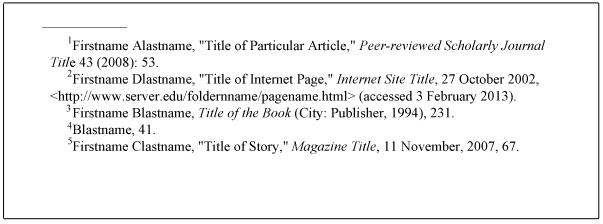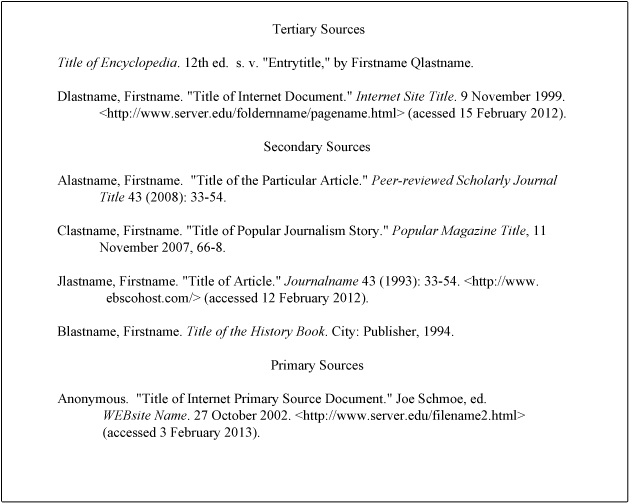Purpose | Quotations | Format | Bibliographies | Common Errors
A. Purpose:
Citation is important because it reveals the quality of work that supports your writing. The kind of sources you use, and how you use them, enables a reader to better evaluate your arguments. A good reference provides enough information so that another person can find the source you have used. Without citation, your professor might think you have committed plagiarism (see the helpful pamphlet, "Help Stop Plagiarism!").
Therefore, you must cite, or note, each and every quote, and/or all other factual information, judgments or analysis drawn from other sources, even when you paraphrase or use your own wording. Not only specific words, but also unique ideas and thoughts need citations. In academic writing, borrowed information, even if it is in your own words, must be cited, since you learned it from your source. That means at the end of every sentence with content information you need to decide whether you need to cite or not.
Deciding what to cite may be difficult. To err in favor of too many rather than too few may be better. Common knowledge or general information that any high school graduate should know (such as "Hitler ruled Germany from 1933 to 1945.") does not need to be cited. Actually much that is taught in survey courses, or in your survey textbooks is general knowledge (one reason why we teach it).
Any use of another person's words or unique ideas, whether quoted or paraphrased, must be properly identified. Not to do so is plagiarism and a violation of Academic Integrity. For more, see The Student Handbook.
So it is probably better to err on the side of caution and cite more often rather than less.
Below are some kinds of information that typically require a citation:
- Statistics or specific numbers.
- Stories from or descriptions by specific individuals.
- Opinions of experts. Especially, every time you write something like "Historians describe/say/believe/state/assert, etc." you need a source! Cite the historians who have provided your information. You do not necessarily need to mention the expert's name in the text of your essay.
- If you claim that some historical figure "believed" or "felt" something, you must also provide a citation. It is perhaps best to avoid such statements, since actions are obvious, but it is difficult to get in another person's mind.
Do not use content notes, where further information is provided on a point made in the text. They should be avoided in papers of this length. Either put the information in the body of the essay or leave it out.
B. Quotations:
For assignments under ten (10) pages you may use only a limited number of quotations. No more than three (3) separate uses and no individual quote may be longer than thirty (30) words. If you use more than three words of another author in a row, a distinct combination of two words, or even a unique emphasis on one word, you are directly quoting that author.
Every use of someone else's exact words must be in "quotation marks." Not to do so is plagiarism and a violation of Academic Integrity. For more, see The Student Handbook.
Why so few quotations? Using your own words to shows your mastery of the material.
Source material you otherwise use means rewriting and paraphrasing your sources. Check the syllabus whether you may quote your sources or not, or how much.
In Turabian/Chicago format, quotes longer than three lines of text must be indented on both sides, single-spaced, with no quotation marks. Since you may not use quotes longer than thirty (30) words, this should not occur in your written assignments.
C. Required Data
Whether in a footnote or bibliographic entry, enough information should be included so that someone else can find the exact location of your source material.
Basically that means author(s), title, editors (if significant), translators (if any), origins (city of publication, Journal title, publisher, URL address, etc.) and date(s). If no author can be found, in footnotes use the title; in the Bibliography you could list it under "N.N." (for no name), or "Anonymous/Anon." If no date can be found, use "n.d."Footnotes also require the exact page number(s) of the source information.
D. Method/Procedure
To cite properly, at the end of the sentence where you have used the information, you should place for the note an Arabic number, slightly superscripted, a bit smaller, immediately after the punctuation mark.1 That number then links to the note proper with the citation information. Those notes should be located as footnotes at the bottom of the page where they are cited (separated from the text by a short, solid line, as below). Do not list them on a separate page labeled as "Endnotes," located after the last page of text and before the Bibliography page. All sources cited in your footnotes must again be listed in your Bibliography.
Citations must be in the TURABIAN (or Chicago Manual of Style) FORMAT. For more
information, see below. It is the style most used by
historians. Some other common styles, which you may NOT use, are MLA or APA.
Citations are numbered sequentially, with each use of any source deserving its
own note (unless a paragraph or several sentences use the same source, but that
should be explained in the note).
Second or later citations of the same source must be in an abbreviated form.2 Latin terms like ibid., loc. cit., or op. cit. are no longer used. If every sentence in a paragraph is from the same source, and you think each might require a note, but you do not want to clutter your paper, you may cite the topic sentence and explain your citing the whole paragraph in your citation. It is better, though, to use numerous sources.
Materials obtained through the internet should be cited with a link, usually in the form of a "URL" (universal rsource locator) or, better, a "doi" (digital object identifier). If you obtain a book or journal article through a database, list its name (such as EBSCOHOST, JSTOR, GOOGLE BOOKS, etc.) at the end of the citation. Include a "doi" if given; only include a "URL" if the link is permanent (e.g. links on EBSCOHOST and some other search engines are not permanent. Do not include them.) Internet links also need to have author, title, publisher, and date information--a URL alone is inadequate.
__________
1Jules R. Benjamin, A Student's Guide to History, 11th ed. (Boston and New York: Bedford/St. Martin's, 2010), 173.
2Benjamin, 176.
E. Exact Format of Citations:
As you can see from the above two examples, Turabian (or Chicago Manual of Style) "Notes and Bibliography" format requires specific punctuation and order for your information. It is often the format used by historians who wrote the journal articles and books of information available for research.
Use the examples below, or for more detailed format guides, see
- Chicago Manual of Style Citation Quick Guide (although the new "Notes and Bibliography" 16th Edition version changes how the accessed date works).
- Benjamin, Jules R. A Student's Guide to History. 11th ed. Boston and New York: Bedford/St. Martin's, 2010;
- Corgan Library "Citing Sources" (use Documentation One style, NOT the parenthetical Documentation Two style) or citation guide.
- Corgan Library Study Guide # 6 (do NOT use the "PARENTHETICAL CITATIONS with a REFERENCE LIST" version on the last page). If you use some automated program make sure it does not use the parenthetical format, but the regular notes and bibliography style with a date at the end of the citation.
Information should be single spaced within each citation. Footnotes should have no double-space/blank lines between citations. They should be at the bottom of the page where the information is used. (When citations are located on a page at the end of the text they are called endnotes). Each citation should be indented on the first line.Use the same font/typeface as in the rest of your paper, although it may be smaller. Only underline or italicize where appropriate; do NOT use boldface.
Sample Foot/endnote Citation Format:

D. Bibliography
A bibliography should list all the sources you have consulted, whether cited in a note or not. Some assignments have a minimum number of sources, and possibly of various kinds (primary, secondary; printed, electronic). (For more on sources, click here for sources.html).
A bibliography is also quite specifically formatted. A bibliography should be the last page or pages of your paper, and should be clearly labeled at the top. The name "Bibliography" should be used instead of "Works Cited" or "Works Consulted." It does not count toward the required number of pages of writing, but is numbered sequentially after the last page of text. Bibliographic citations are listed in alphabetical order using the author's last name. Citations should be listed in particular categories, "Tertiary Sources," "Secondary Sources," and "Primary Sources." References should be single spaced (although it is usual in shorter bibliographies to have a blank line between references; if the whole text is single spaced, there must be a hanging indent for each first line. They are not numbered or bulleted.
Sample Bibliography Format or click here:

Try to avoid these mistakes in citation format which students make too often:
-
Wrong indents (should be hanging for bibliography, first line indent for foot/endnote).
-
No periods at end of citation (every citation should end with a period).
-
Missing information for internet source (citations should have author, webpage, website, and, especially dates (both of the page's creation and the date you accessed or viewed the page).
-
No city listed for publisher.
-
Incorrect abbreviation for state (choose one format (postal or standard) and stick with it consistently; and remember, postal abbreviations have no periods).
-
No single spacing with citation longer than one line (although you could have a space between individual citations).
-
Reversing order of author names between foot/endnote (first name first) and bibliographic citation (last name first).
Any use of another person's words or unique ideas, whether quoted or paraphrased, must be properly identified. Not to do so is plagiarism and a violation of Academic Integrity. For more, see The Student Handbook.
See also presentation.html for other issues about paper presentation.
These pages may be printed and used, |
URL: http://brianpavlac.org/teach/thCiting.html |
